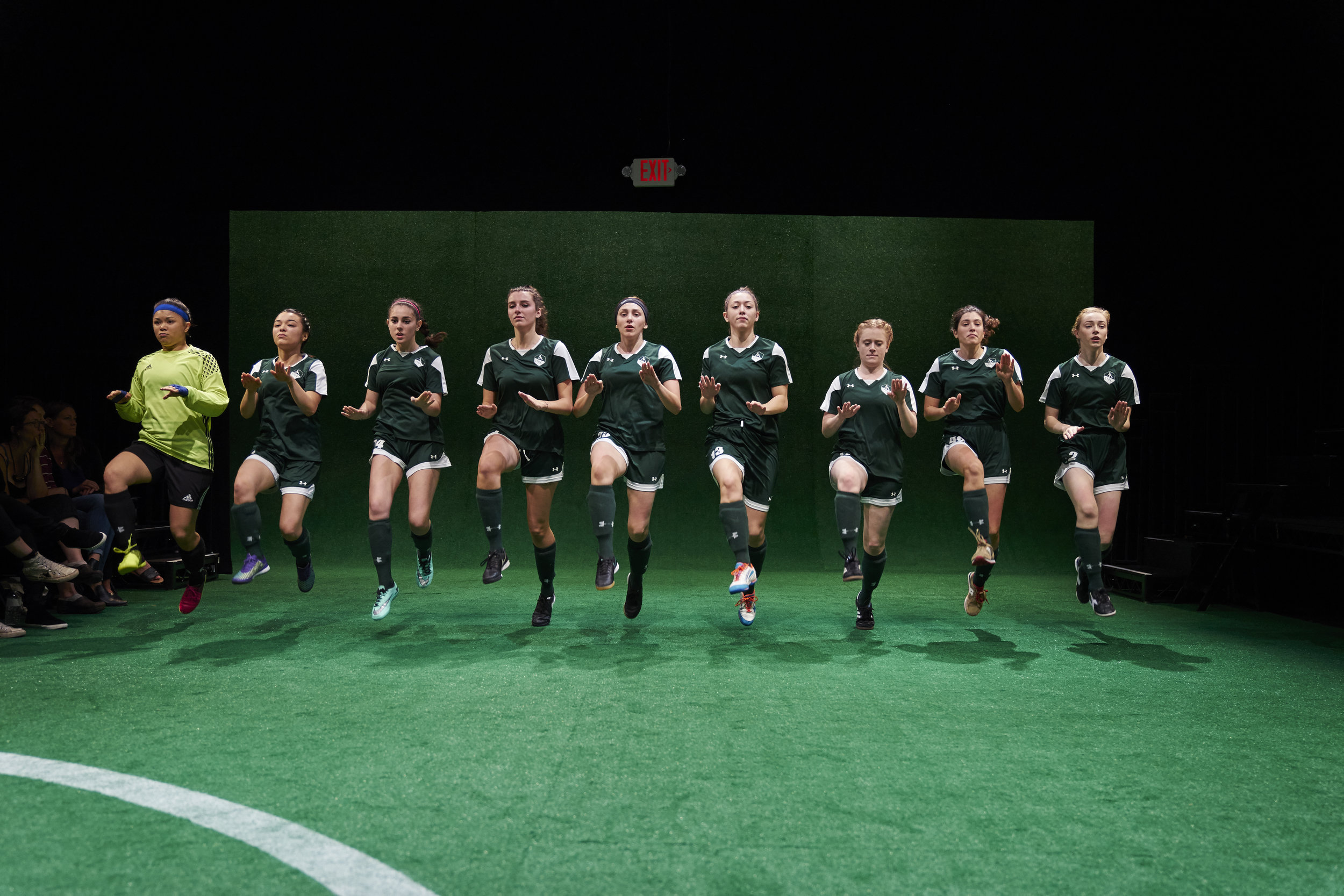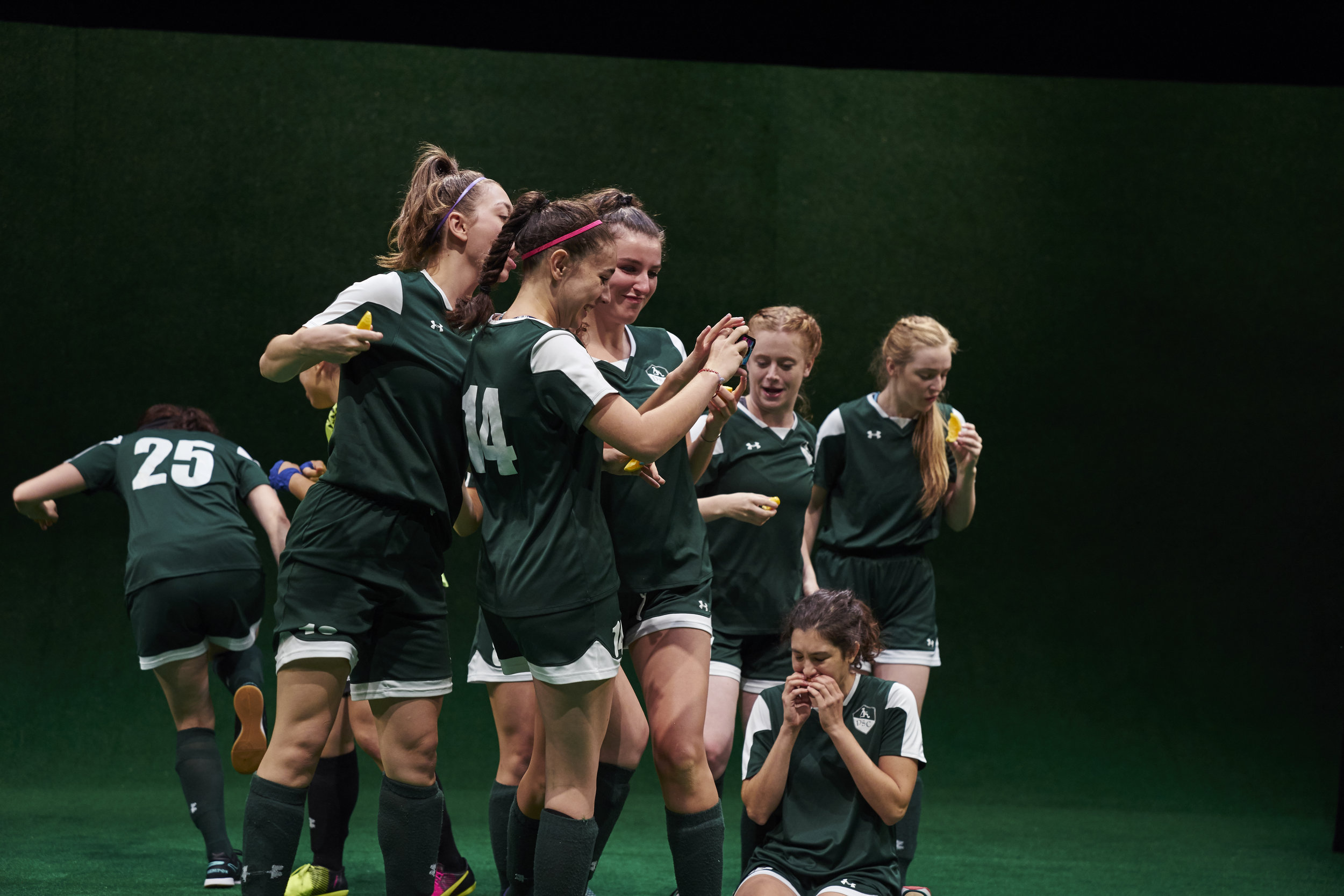
Oh to experience the world of a teenage girl in ninety minutes (disclosure: I wish my teenage years had only lasted ninety minutes). When I sat in the Duke on 42nd in New York City, next to the green, green astroturf and girls in shorts dribbling soccer balls, I found myself back at sixteen—no more acne or braces, but with a distinct sense of longing for a time that felt both limitless and impossibly constricting. Sarah DeLappe’s The Wolves has—naturally—excited audiences from Vassar to Playwrights Realm to, now, Lincoln Center. And it deserves it: The Wolves is a beautiful, funny, weird, lovely play and I cried when I first read it, I cried when I saw it Off-Broadway, and I’ll cry when I see it at Lincoln Center.
But something else about The Wolves struck me as I first read it: it was about girls. Girls! Ever since I’d cracked open a teenage monologue book when I was auditioning for the school play, I’ve found it impossible to find plays about girls. Sure, you have your myriad Little Women adaptations and I guess Annie is a tween, but where are the plays about teenage girls?
So I took to Facebook. I posed the question to my friends, asking them to shout out as many plays about teenage girls by women as they could think of. The Wolves was joined by Dry Land, last season’s favorite about two friends on a swim team, featuring a medically-induced abortion.
But otherwise? A lot of head-scratching. (Granted, these are produced plays I’m counting. Unproduced plays—and unrepresented plays—took up a wide swath of this list.)
My Kilroys List Jr. was very short—just thirty-two plays total. And, rest assured, I surround myself with people who enjoy sitting at home with plays as a way of life. If anyone could compile this list, it was the 1,069 dramaturgy nerds I call my Facebook friends.
Now, as an agent and dramaturg, I see this question as a matter of great importance to our theatrical ecosystem. If we take our New Play Map (thanks, HowlRound!), how much of it will contain plays by women about young women? The Lilly Awards’ THE COUNT tells us that 22 percent of the plays on your screen would be written by women. And The Kilroys would tell you that, despite a huge amount of female writers graduating from prestigious grad schools and snagging agents, they still can release an extensive list of unproduced plays. And, in looking at catalogues for this season Off-Broadway and on Broadway, I could only scrounge up two (brilliant, thrilling) plays by women about young women: The African Mean Girls Play by Jocelyn Bioh and…The Wolves. (honorable mention to Michael Crowley’s The Rape of the Sabine Women, by Grace B. Matthias, which is, perhaps, one of the most sympathetic portrayals of a young woman by a man that I’ve ever read).
What gives? According to the Broadway League’s 2015 study, over 1.45 million teenagers saw a Broadway show in the 2014–2015 season, and 67 percent of theatregoers were female (their average age? Forty-four, just old enough to be raising a teen). That’s not counting Off-Broadway, LORT theatres, college conservatories, high schools, your friend’s backyard, community theatre…If my memory serves me and my intern applications keep coming up overwhelmingly female, I would argue that teenage girls are some of the most ardent theatregoers around. So why don’t we have more stories about them? And why, oh why, are more theatres not choosing to put teenage women at the center of their stories following the success of The Wolves?
It’s not that teenage girls haven’t been onstage, per se. After all, many male coming-of-age stories feature a young woman prominently (think Kenneth Lonergan’s This Is Our Youth or Anna Jordan’s Yen), as do Shakespearean classics like Romeo and Juliet and Hamlet. But rarely do we see women at the center of their own stories rather than as objects of desire—or victims of violence (one could write a whole series on bodily harm done to young girls onstage and our culture’s fascination with sexual violence).
But to focus on the inner lives of teenage girls—to portray them as subject rather than object—is something that seems to have evaded us. While the Judy Blumes of the novelistic world were born, something stayed dormant in the theatre community “Agency is something I want to see more of in plays about women,” Playwrights Horizons literary manager Sarah Lunnie told me over drinks as we pondered my list. I wanted it too: women who do things, not have things done to them. Did this seem too much to ask?
Maybe it’s the idea that only certain people can inhabit the world of drama. After all, before Willy Loman, we weren’t much interested in the everyman—let alone the everywoman. Theatre has often been reserved for the rich and proud and high in stature: if the 2016 election shows us anything, it’s that these seats aren’t open to even the most privileged of women. Indeed, when looking at the plays that do pass the teenage girls test, it’s worth noting that most take place in the suburban, primary white, and decidedly upper middle-class sphere. Is this surprising considering the high price tag of most MFA programs and the demographic makeup of most audiences? Well, no. But it is worth saying that male characters have their Sam Hunters and David Lindsay-Abaires, writers who focus on lower-income male characters. Female teens seem to have…no one. Aside from Kirsten Greenidge’s Milk Like Sugar, the majority of the list I compiled portrayed women in positions of relative financial security. And, as in the rest of stories represented onstage, the list was overwhelmingly white—Milk Like Sugar, BFE by Julia Cho, and Out Lady of Kibeho by Katori Hall were the only plays by women of color. None of the plays on the list were written by trans women.
The cast of The Wolves at Playwrights Realm (Daniel Velasquez)
To be a teenage girl is to be blisteringly vulnerable—to talk about periods, first kisses, crushes, sexual awakenings, fantasies, dying your hair in the sink, going shopping at Forever 21, crashing your mom’s car. Teenage girls are difficult and intense and awkward and unapologetically female. And perhaps, I wonder, that’s why we won’t put these stories onstage. After all, male theatre critics are slow to take to plays that play girlish. “I didn’t care for the show the first time I saw it. Female empowerment is fine for daytime television, but it’s flesh-crawling in a musical,” wrote Michael Reidel of teen-centric The Color Purple’s revival in 2015.
And the darkest thought remains: there’s much cause to think that our society may just have a seething hatred of teenage girls—point-blank. There are the capital M Misogynistic things: the Steubenville rape case, cuts in funding for the Teen Pregnancy Prevention Program, which works with organizations across the United States to implement evidence-based, proven programming, the erasure of Title IX protections by the Trump administration, a lack of sex education with a focus on issues of consent and female pleasure. There are the slyer, more creakingly sexist things: internalized misogyny. The way we dismiss young women’s emotions as irrational or dishonest or dangerous. How we tell girls to hide their tampons in their bags, their opinions in their throats, and their anger in their stomachs.
But, in my more optimistic moments, I think we do not have these plays because we are only just beginning. I think the most optimistic way to look is forward—and I think we must do so to create change. We will know trans girls and undocumented girls and girls who are not skinny and girls who are not “nice” and girls who like girls and girls who don’t particularly like anyone and girls who are unlikable and gross and mean and horrible.
On good days, I am excited for this future season of bustling teenage brilliance to come. On bad days, I wonder if we are too late for someone—if we’ve left too many young girls out in the cold and exiled them out of the theatre. I don’t want to think of that scenario, but think about it we must if we’re going to take full responsibility for our power as gatekeepers.
For me, perhaps the most exciting part of The Wolves was when the lights came up on a jumble of female bodies—different shapes, queer bodies, brown bodies, athletic bodies, bodies that looked like my friends’ bodies, and bodies that looked like my body. It was exhilarating to see myself at sixteen onstage. I hope to have this experience again soon—one I wish I had known when I was a teenage girl.
LIST*
The Wolves by Sarah DeLappe
Milk Like Sugar by Kirsten Greenidge
Dry Land by Ruby Rae Spiegel
I’ll Never Love Again by Clare Barron
Chimichangas and Zoloft by Fernanda Coppel
Our Lady of Kibeho by Katori Hall
How to Make Friends and Then Kill Them by Hailey Feiffer
All The Roads Home by Jen Silverman
Dance Nation by Clare Barron
BFE by Julia Cho
tender of you too by Anya Richkind
Children’s Hour by Lillian Hellman
Horse Girls by Jenny Rachel Weiner
Little One by Hannah Moscovitch
Scratch by Charlotte Corbeil-Coleman
I Am For You by Mieko Ouchi
Scorch by Stacey Gregg
Joan by Lucy Skillbeck
SHE by Renée Roden
How I Learned to Drive by Paula Vogel
Jailbait by Deidre O’Connor
School Girls; Or, The African Mean Girls Play by Jocelyn Bioh
Geek! by Crystal Skillman
Chill by Eleanor Burgess
Honors Students by Mariah MacCarthy
*Note: this is a crowd-sourced list and certainly not comprehensive. If you know of other plays by women about teenage girls, please add them in the comments!
This piece, “Teenage Girls on Stage: Young Women Who Do Things” by Helen Schultz was originally published on HowlRound, a knowledge commons by and for the theatre community, on October 13, 2017.

Noël Coward’s Travels

Kate Chopin in New Orleans: Mother-Daughter Author Duo Collaborate on Historical Book


